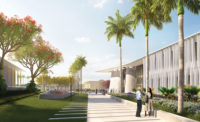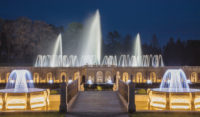As part of a master plan initiated in 2010, Longwood Gardens in Kennett Square, Pennsylvania, announced today its plans for transforming 17 acres of its botanical gardens, woodlands, and meadows. The New York firm of Weiss/Manfredi are the architects at the helm of new buildings, outdoor spaces, and refined connections between its east and west precincts, in association with landscape architect Reed Hilderbrand of Cambridge, Massachusetts.
The design team’s signature addition is a 32,000-square-foot glass conservatory that appears to float on top of pools and plantings. The ethereal new West Conservatory is a modern companion to the “mineral expression,” as architect Marion Weiss says, of the traditional East and Main Conservatories—separate but connected buildings. The new structure’s pleated roofline undulates, creating forced perspectives and recalling the surrounding Brandywine Valley’s topography. The building’s hovering expression will be achieved in part by four sets of graceful tree-like steel columns. Operable glass walls and roof gills will provide passive ventilation, and a series of underground earth tubes will draw fresh air in and up through the conservatory.
Weiss and her firm partner and husband Michael Manfredi, along with Reed Hilderbrand, are also designing a new 3,800-square-foot glass house for Brazilian landscape architect Roberto Burle Marx’s 1992 tropical garden; a new vaulted restaurant and event space carved behind an 18-foot-tall ivy-covered retaining wall that faces the Main Fountain Garden; a new education and administration building; and an outdoor, gallery-like bonsai courtyard. Six historic Lord & Burnham glass houses from the early 20th century are being carefully deconstructed and will be rebuilt at a later date.
The team’s plan follows a historic and additive lineage in landscape design: In Pierre S. du Pont’s instinctive sculpting of Longwood Gardens' 1,077 acres, on his rural estate in the early 20th century, the inventor, industrialist, and conservationist was inspired by the technical innovation he saw at world’s fairs and expositions and the splendor of international gardens. From 1906 to 1954, du Pont used the latest technology to impress guests at Longwood with theatrical displays of plants, a fountain garden with a pioneering hydraulic system, and the grand East Conservatory built in 1921 and powered by underground systems that didn’t detract from the decorative fruits and flowers.
This current project has evolved from the 40-year master plan developed in 2010 by Weiss/Manfredi and West 8 Urban Design & Landscape Architecture. “West 8 remains very much a part of our team and consults from time to time on realizing these projects,” wrote Longwood CEO and President Paul B. Redmond in an email. “One of the distinguishing factors [of the master plan] is our legacy of being a patron of landscape architecture and garden design as well as having one of the greatest collections of landscapes designed by some of the most noted landscape architects of the 20th and 21st century.” In 2017, Longwood celebrated the restoration and enhancement of the Main Fountain Garden.
Site plan courtesy WEISS/MANFREDI with Reed Hilderbrand for Longwood Gardens
As part of its decade-long involvement with Longwood, Weiss and Manfredi rethought the western portion of the gardens, which, as Weiss says, was an often-overlooked workhorse and “service wing.” The architects arrived at the current West Conservatory after rigorous study of historic glass structures and scales (attested by 40 different models in their Manhattan office). The final football field-sized structure isn’t just big for bigness’s sake. “It is the companion to the historic conservatory complex," says Weiss. “It needed to balance things. It’s generous in scale, but you could say that the glass is sheltering a Mediterranean garden that is an inhabitable landscape.”
As part of this undertaking the team is also relocating Burle Marx’s Cascade Garden. Failing mechanical systems and leaks have made it difficult for the tropical plants to survive winters. In addition, Longwood determined that the small greenhouse containing Burle Marx’s work of botanical art was literally constraining the plants’ growth. “The idea of moving it to a slightly more central location, between the historic conservatory and new one, would give it a much more prominent sense of place and location,” says Manfredi. The task will be a delicate one, and involve transporting richly decorated columns that were part of Burle Marx’s design, as well as positioning the garden in the exact south-facing orientation.
Funding is coming from the sale of tax-exempt bonds, Longwood’s endowment, and a donation from the Longwood Foundation, a separate entity from the Gardens established by du Pont to support its continued operations. The multiyear project and its components will open simultaneously, but Longwood did not specify a completion date. At a time when well-designed and accessible outdoor space is not simply a luxury, but a necessity, this next phase of Longwood will likely expand its mission.











